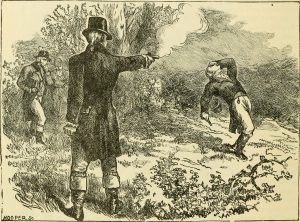Herbicidal warfare became popular when the United States Army decided to use it to weaken the enemy during the Vietnam War. Herbicides are chemicals that are toxic to plants and help destroy unwanted weeds that compete with crops for water, sunlight, and nutrients. The U.S. Army sought to create a unique herbicide that would destroy vegetation as a way of reducing food supplies and clear tall grasses from the outskirts of U.S. base camps for visibility in Vietnam.1 As U.S. Army wartime government contractors, Monsanto Company, Dow Chemical Company, Diamond Shamrock, and other manufactures produced what became known as Rainbow Herbicides. The government set the conditions for making each herbicide, along with how they were to be used.2 The herbicides were named according to the colored stripes on their containers, such as Agent Blue, Agent Green, Agent White, Agent Yellow, and Agent Orange. Nonetheless, Agent Orange was the most widely used herbicide in Vietnam. The ingredients of Agent Orange consisted of two equal amounts of plant-growth regulators developed during World War II, 2,4-dichlorophenoxyacetic and 2,4,5-trichlorophenoxyacetic. However, during the production of Agent Orange an unexpected event occurred, it was contaminated by 2,3,7,8-tetrachlorodibenzo-p-dioxin, a type of dioxin also known as TCDD. Unaware of this pollution, the U.S. army began to test and utilize Agent Orange.
Dioxins are produced through various incineration processes, such as the burning of waste, oil, or coal that is then released into the air. Dioxins last many years in the environment, specifically in soil and bodies of water, which lead to human exposure through foods, including fish, poultry, and other meats. The TCDD-dioxin was one of the most toxic substances known to humankind. Exposure to TCDD could fluctuate cell growth and hormones and affect the reproductive system. TCDD-dioxin had both short and long-term effects. Short-term exposure could cause liver problems, chloracne – a type of acne-related skin disease, and darkening of the skin. On the other hand, the long-term effects included nerve disorders, type 2 diabetes, cancers, and heart disease.3 Research of human studies also showed that exposure to Agent Orange dioxin was associated with birth defects, such as missing limbs, cleft palate, and missing facial features.4 Additionally, dioxin could remain present in the human body for eleven to fifteen years, but might last as long as twenty years.5 For this reason, in 1997, the World Health Organization included the TCDD in Agent Orange as carcinogenic (cancer-producing) to humans. Three years later, the U.S. Environmental Protection Agency (EPA) claimed dioxins contained in Agent Orange were “potent and persistent animal toxicants with potential to cause widespread human health effects.”6 Overall, the total dioxin in Agent Orange dropped in Vietnam amounted to 366 kg, also being the world’s largest dioxin contamination.
The U.S. Army conducted the first domestic tests of Agent Orange during the 1950s at Camp Drum, New York and at Eglin Air Force Base, Florida. Then, during the fall of 1961, President John F. Kennedy authorized the first field tests in South Vietnam.7 Agent Orange was only tested or stored inside and outside U.S. military bases. Within the U.S., the Department of Defense (DoD) reported conducting tests, disposing of, or storing these Rainbow Herbicides in Arkansas, Florida, Georgia, Maryland, Tennessee, Texas, and Utah. Locations outside the United States consisted of Cambodia, Canada, Johnson Atoll, Korea, Laos, and Thailand.8

After a year of testing, on September 25, 1962, President Kennedy approved for Agent Orange to be sprayed on Vietnamese food crops and forests. The use of Agent Orange became a ten-year chemical warfare between 1962 and 1971 known as Operation Ranch Hand. It was sprayed throughout Vietnam, Cambodia, and Laos. The process of this herbicide was to be stored, then put into spraying equipment, and finally sprayed or spilled with airplanes, boats, truck, or hand-sprayers.
The TCDD-dioxin in Agent Orange negatively affected U.S. veterans stationed in Vietnam, Korean-Vietnam veterans, and Vietnamese soldiers and civilians. During these ten years, as many as four million people were directly sprayed. After the war, many veterans reported returning home and having multiple children with defects.9 After much research, studies found that the TCDD-dioxin in Agent Orange was associated with several diseases common to those exposed to it. Agent Orange-associated diseases include Hodgkin’s Disease, Multiple Myeloma, Parkinson’s Disease, Prostate Cancer, Respiratory Cancers, Soft Tissue Sarcomas, Chronic B-cell Leukemias, Chronic Lymphocytic Leukemia, and many others.10

In 1968, Dr. Nguyen Thi Ngoc Phuong created a residential nursery and home in Tu Du Hospital for handicapped babies that were affected by Agent Orange. She had preserved dozens of deformed fetuses to use as evidence of the negligence that former South Vietnam and U.S. government had on the side effects the herbicide contained, which remain at the hospital today.11 Approximately four-hundred thousand victims were killed or injured by Agent Orange and more than two million people are suffering from cancer and other Agent Orange-associated diseases.12 In 1991, Congress, along with President George H.W. Bush, passed the Agent Orange Act, establishing that any veteran who served in Vietnam for any amount of time and suffered from any Agent Orange-associated disease is eligible for healthcare and disability compensation.13 The Vietnamese victims did not receive any compensation from the U.S. government or manufacturer that created Agent Orange for thirty-six years. It was not until 2007 that the U.S. Congress funded nine million dollars for cleanup of sites exposed to herbicides, including Agent Orange.14 This was possible through the help of the Vietnam Agent Orange Relief & Responsibility Campaign, consisting of a national coalition of veterans, Vietnamese American, and other community leaders, in their lawsuit against the U.S. chemical companies. Today, forty years after the Vietnam War, children born to U.S. Vietnam veterans, Vietnam soldiers and civilians, and their grandchildren are still suffering from Agent Orange. A common birth defect in children of U.S. veterans is Spina Bifida – a defect that occurs to a fetus when the spine and spinal cord do not form properly.15 Meanwhile, in Vietnam, second and third-generation children are unable to care for themselves due to being born without eyes, arms, fingers, legs, and some being born dead.

After more than thirteen million gallons of Agent Orange were sprayed in Vietnam by the United States, it was suspended by Congress on April 15, 1970.16 Yet, the former Southern Vietnamese military continued spraying various herbicides left by the United States until 1972. It came as a surprise to many when in 1971, President Richard Nixon was forced to release government-sponsored research data that proved one of the herbicides in Agent Orange caused “extreme birth deformities in lab animals” and harmful reproductive defects. Evidence showed that major manufacturers, including Dow Chemical, knew that this herbicide had a higher concentration of dioxin contamination, yet refused to inform the government “to avoid regulation and loss of profits.”17 Then, in September 1971, the American Chemical Society found that the TCDD-dioxin in Agent Orange showed “patterns of absorption and of distribution among organs were beginning to emerge,” later confirmed by the National Institute of Environmental Health Sciences in North Carolina.18
Controversies arose during the early and mid-1970s when U.S. Vietnam veterans began to notice a correlation between their unexpected diseases and their exposure to Agent Orange. In 1977, a Vietnam Veteran by the name of Charles Owen became the first predicted victim of Agent Orange to die of terminal cancer. A year later, Paul Reutershan, a former helicopter chief during the Vietnam War, appeared on the Today Show and said that he was told by the U.S. Army that Agent Orange was “nontoxic to humans and animals.”19 That same year, Paul died of pancreatic cancer. It was not until 1978 that Agent Orange was completely destroyed in the United States and all around the world.

Before Paul’s death, he was convinced that his cancer was linked to being exposed to Agent Orange and urged Edward Gorman, a personal injury lawyer, to file a lawsuit in a New York State court against Dow, Monsanto, and Diamond Shamrock.20 While forming a class action lawsuit, Paul reunited with two other Vietnam veterans, Frank McCarthy and Jimmy Sparrow, and formed the Vietnam Veterans Agent Orange Victims (VVAOV), a non-profit organization that helped veterans and families who were affected by Agent Orange, known today as the HonorBound Foundation.21 The lawsuit was officially filed on January 8, 1979, in the U.S. District Court for the Southern District of New York in Manhattan, addressing five chemical manufacturers responsible for the production of the chemicals of Agent Orange. Six years later, the parties reached and approved a settlement that obliged the chemical manufacturers to fund $180 million for those disabled and the survivors of deceased veterans over ten years and help the needs of the members of the class suit.22 To this day, numerous lawsuits are being charged on behalf of veterans who were exposed to Agent Orange, as well as an increase of organizations that help and advocate for Vietnam veterans and their children. The life of Agent Orange began as a promising and trouble-free tactic to help the United States combat the enemy, but proved to have adverse side effects.
- Jeanne Mager and Steven D Stellman, “Agent Orange During the Vietnam War: The Lingering Issue of Its Civilian and Military Health Impact,” American Journal of Public Health 108, no. 6 (2018): 726. doi:10.2105/AJPH.2018.304426. ↵
- Monsanto, “Agent Orange: Monsanto’s Involvement,” Monsanto, April 7, 2017, https://monsanto.com/company/media/statements/agent-orange-background/. ↵
- National Institute of Environmental Health Sciences, “Dioxins,” U.S. Department of Health and Human Services, Accessed March 2, 2020, https://www.niehs.nih.gov/health/topics/agents/dioxins/index.cfm. ↵
- Patricia Hynes, “The Legacy of Agent Orange in Vietnam,” Peace Review 28, no. 1 (2016): 117. doi:10.1080/10402659.2016.1130415. ↵
- Aspen Institute, “What Is Agent Orange?,” The Aspen Institute, Accessed March 2, 2020, https://www.aspeninstitute.org/programs/agent-orange-in-vietnam-program/what-is-agent-orange/. ↵
- Michael G. Palmer, “The Case of Agent Orange,” Contemporary Southeast Asia: A Journal of International & Strategic Affairs 29, no. 1 (2017): 173. ↵
- Robert D. Engelken, “Agent Orange (AO),” Encyclopedia of Environmental Issues, Revised Edition (Online Edition) (2018). ↵
- US Department of Veterans Affairs, and Veterans Health Administration, “Herbicide Tests and Storage Outside Vietnam,” Veterans Affairs Protect your Health, December 17, 2013, https://www.publichealth.va.gov/exposures/agentorange/locations/tests-storage/index.asp. ↵
- Michael G. Palmer, “The Case of Agent Orange,” Contemporary Southeast Asia: A Journal of International & Strategic Affairs 29, no. 1 (2017): 174. doi:10.1355/CS29-1H. ↵
- US Department of Veterans Affairs, and Veterans Health Administration, “Veterans’ Diseases Associated with Agent Orange,” Veterans Affairs Protect your Health, December 10, 2013, https://www.publichealth.va.gov/exposures/agentorange/conditions/index.asp. ↵
- Patricia Hynes, “The Legacy of Agent Orange in Vietnam,” Peace Review 28, no. 1 (2016): 118. doi:10.1080/10402659.2016.1130415. ↵
- History.com Editors, “Agent Orange,” A&E Television Networks, 2011, https://www.history.com/topics/vietnam-war/agent-orange-1. ↵
- Michael G. Palmer, “The Case of Agent Orange,” Contemporary Southeast Asia: A Journal of International & Strategic Affairs 29, no. 1 (2017): 174. doi:10.1355/CS29-1H. ↵
- Patricia Hynes, “The Legacy of Agent Orange in Vietnam,” Peace Review 28, no. 1 (2016): 119. doi:10.1080/10402659.2016.1130415. ↵
- US Department of Veterans Affairs, and Veterans Health Administration, “Veterans’ Diseases Associated with Agent Orange,” Veterans Affairs Protect your Health, December 10, 2013, https://www.publichealth.va.gov/exposures/agentorange/conditions/index.asp. ↵
- History.com Editors, “Agent Orange,” A&E Television Networks, 2011, https://www.history.com/topics/vietnam-war/agent-orange-1. ↵
- Patricia Hynes, “The Legacy of Agent Orange in Vietnam,” Peace Review 28, no. 1 (2016): 119. doi:10.1080/10402659.2016.1130415. ↵
- Alvin L. Young, “Agent Orange and Its Associated Dioxin: Assessment of a Controversy,” Amsterdam: Elsevier (1988). ↵
- Fred A. Wilcox, “Waiting for an Army to Die: The Tragedy of Agent Orange,” Cabin John, MD: Seven Locks Press, 1989. ↵
- Institute of Medicine (U.S.), “Veterans and Agent Orange: Health Effects of Herbicides Used in Vietnam,” Washington, D.C.: National Academy Press (1994): 34. ↵
- “Our Story,” HonorBound Foundation, Accessed March 3, 2020. https://www.honorboundfoundation.org/our-story/. ↵
- Institute of Medicine (U.S.), “Veterans and Agent Orange: Health Effects of Herbicides Used in Vietnam,” Washington, D.C.: National Academy Press (1994): 35. ↵




52 comments
Camryn Blackmon
This is a very difficult topic, but you wrote about it so well and provided a lot of important information and detail. I knew very little about this topic, but there is so much involved, and it is awful how the U.S. did not really take accountability until much later, and it still cannot reverse the mass damage already done to Vietnam. I also did not realize that generations after the war are having to deal with the consequences from the U.S. The U.S. had already caused so much trauma and instability for Vietnam in other ways.
Alicia Martinez
I had no idea of the long term side effects that came from chemicals used during Vietnam. Considering that it was under the Nixon Administration where research findings were released about the harmful effects of Agent Orange, I wonder if President Kennedy knew all the details before authorizing use of the harmful agent. Though it took many years for the U.S government to provide compensation for those effected, it is disappointingly not surprising that the government had been reluctant to right their wrongs and try to hide the truth for so long.
Madeline Chandler
Such an informative and interesting article! Very captivating. Honestly I am unfamiliar with this side of Vietnam and wish I knew more. I knew that Vietnam was a devastating time yet I had know idea about Agent Orange . This article gave such great information about the combat side of war. As well as the transition of a country during tragic thing that happened. Because of this article it gave great insight into Vietnam, Agent Orange, and United States history. I loved reading your article. Great job!
Danielle Litman
The fact that the United State used Agent Orange is still appalling to this day. Agent Orange caused short and long term effects,this agent did nothing but harm. The vietnam war was in the 60’s but it wasn’t until 1997 that the World Health Organization recognised Agent Orange as a carcinogen. The United states claims to be one of the top nations, but this article is proof that the U.S is not as great as it appears to be.
Alyssa Ramos
I have never heard about herbicides or Agent Orange before. I feel like this should be a section in History classes in High school. It is horrible to see the long-term affects those in Vietnam have to endure. Also, it is crazy to think about how powerful chemicals can be that they can cause major problems for years. It not only affects the individual, but it also affects the offspring and the family line to come. I am glad that the people in Vietnam are getting some compensation now because they deserved it for how damaging Agent Orange was.
Kayla Mendez
Topics like these, ones that harm the U.S. reputation, are hardly learned about in school. It’s heartbreaking, knowing that so many innocent people’s health were affected permanently. The worst part is that the impact doesn’t disappear with these individuals, it’ll continue on throughout their heritage. Although actions to aid those affected by Agent Orange were late, at least they received some compensation. As for those who are still looking for justice, through law suits, I hope they receive all the help and empathy they deserve.
Cayden Garcia
I had never heard of the use of herbicides during the Vietnam war before reading your article. It is crazy to think about how one malfunction in the mixing of chemicals caused such a dangerous chain reaction. Agent Orange was a catastrophic creation that cost the lives of many humans. It is additionally crazy to think that it took so long for the facts about the chemical to be provided to the public. Hopefully, something like this never happens again.
Nathan Castillo
After learning about the wars in US history back in high school, this event really stood out to me when going over it. Even with the US basically losing the war, the thought of how much damage we left behind in Vietnam is terrible to recollect on. I am glad that there was someone out there to help take care of these victims, but they are still scarred. Along with the deformities, many of the victims got diagnosed with cancer and it just horrible to hear about.
Andres Garcia
I have always been curious about the long term effects of the products that are used in combat as well as a day to day basis. We use tons of products on a daily basis that we may not even know the effects of because there has not been enough time to determine what the longterm side effects are. What’s alarming about this story is that the effects of the chemicals were known, yet the agent orange was still used in large amounts throughout Vietnam. Although there were campaigns and legislation set in place to make up for the inhumane usage of this chemical, no amount of money can make up for the generations affected.
Janaya Felder
It’s shocking that to this day, there are still children being born with birth defects from the use of Agent orange. I had known of how severe the issues were of the use of the herbicide in Vietnam, however the fact that so many adults and children are still suffering from it is astounding. This is a very well composed article full of detail.